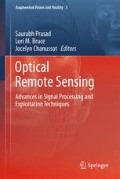Abstract
High-dimensional data such as hyperspectral imagery is traditionally acquired in full dimensionality before being reduced in dimension prior to processing. Conventional dimensionality reduction on-board remote devices is often prohibitive due to limited computational resources; on the other hand, integrating random projections directly into signal acquisition offers an alternative to explicit dimensionality reduction without incurring sender-side computational cost. Receiver-side reconstruction of hyperspectral data from such random projections in the form of compressive-projection principal component analysis (CPPCA) as well as compressed sensing (CS) is investigated. Specifically considered are single-task CS algorithms which reconstruct each hyperspectral pixel vector of a dataset independently as well as multi-task CS in which the multiple, possibly correlated hyperspectral pixel vectors are reconstructed simultaneously. These CS strategies are compared to CPPCA reconstruction which also exploits cross-vector correlations. Experimental results on popular AVIRIS datasets reveal that CPPCA outperforms various CS algorithms in terms of both squared-error as well as spectral-angle quality measures while requiring only a fraction of the computational cost.
Access this chapter
Tax calculation will be finalised at checkout
Purchases are for personal use only
Notes
- 1.
- 2.
- 3.
References
Jolliffe, I.T.: Principal Component Analysis. Springer-Verlag, New York (1986)
Prasad, S., Bruce, L.M.: Limitations of principal component analysis for hyperspectral target recognition. IEEE Geosci. Remote Sens. Lett. 5(4), 625–629 (2008)
Wang, J., Chang, C.-I.: Independent component analysis-based dimensionality reduction with applications in hyperspectral image analysis. IEEE Trans. Geosci. Remote Sens. 44(6), 1586–1600 (2006)
Lennon, L., Mercier, G., Mouchot, M.C., Hubert-Moy, L.: Independent component analysis as a tool for the dimensionality reduction and the representation of hyperspectral images. In: Proceedings of the International Geoscience and Remote Sensing Symposium, vol. 6, Sydney, Australia, July 2001, pp. 2893–2895
Roweis, S.T., Saul, L.K.: Nonlinear dimensionality reduction by locally linear embedding. Science 290(5500), 2323–2326 (2000)
Mohan, A., Sapiro, G., Bosch, E.: Spatially coherent nonlinear dimensionality reduction and segmentation of hyperspectral images. IEEE Geosci. Remote Sens. Lett. 4(2), 206–210 (2007)
Candès, E., Romberg, J., Tao, T.: Robust uncertainty principles: exact signal reconstruction from highly incomplete frequency information. IEEE Trans. Inf. Theory 52(2), 489–509 (2006)
Candès, E., Tao, T.: Near-optimal signal recovery from random projections: universal encoding strategies?. IEEE Trans. Inf. Theory 52(12), 5406–5425 (2006)
Donoho, D.L.: Compressed sensing. IEEE Trans. Inf. Theory 52(4), 1289–1306 (2006)
Candès, E.J., Wakin, M.B.: An introduction to compressive sampling. IEEE Signal Process. Mag. 25(2), 21–30 (2008)
Fowler, J.E.: Compressive-projection principal component analysis for the compression of hyperspectral signatures. In: Storer, J.A., Marcellin, M.W. (eds.), Proceedings of the IEEE Data Compression Conference, Snowbird, UT, March 2008, pp. 83–92
Fowler, J.E.: Compressive-projection principal component analysis and the first eigenvector. In: Storer, J.A., Marcellin, M.W. (eds.), Proceedings of the IEEE Data Compression Conference, Snowbird, UT, March 2009, pp. 223–232
Fowler, J.E.: Compressive-projection principal component analysis. IEEE Trans. Image Process. 18(10), 2230–2242 (2009)
Willett, R.M., Gehm, M.E., Brady, D.J.: Multiscale reconstruction for computational spectral imaging. In: Bouman, C.A., Miller, E.L., Pollak, I. (eds.), Computational Imaging V, Proceedings of SPIE 6498, San Jose, CA, January 2007, p. 64980L
Pitsianis, N.P., Brady, D.J., Portnoy, A., Sun, X., Suleski, T., Fiddy, M.A., Feldman, M.R., TeKolste, R.D.: Compressive imaging sensors. In: Athale, R.A., Zolper, J.C. (eds.), Intelligent Integrated Microsystems, Proceedings of SPIE 6232, Kissimmee, FL, April 2006, p. 62320A
Brady, D.J.: Micro-optics and megapixels. Opt. Photon. News 17(11), 24–29 (2006)
Parlett, B.N.: The Symmetric Eigenvalue Problem. Society for Industrial and Applied Mathematics, Philadelphia (1998)
Combettes, P.L.: The foundations of set theoretic estimation. Proc. IEEE 81(2), 182–208 (1993)
Penna, B., Tillo, T., Magli, E., Olmo, G.: A new low complexity KLT for lossy hyperspectral data compression. In: Proceedings of the International Geoscience and Remote Sensing Symposium, vol. 7, Denver, CO, August 2006, pp. 3525–3528
Du, Q., Fowler, J.E.: Low-complexity principal component analysis for hyperspectral image compression. Int. J. High Perform. Comput. Appl. 22(4), 438–448 (2008)
Chen, S.S., Donoho, D.L., Saunders, M.A.: Atomic decomposition by basis pursuit. SIAM J. Sci. Comput. 20(1), 33–61 (1998)
Candès, E., Romberg, J., Tao, T.: Stable signal recovery from incomplete and inaccurate measurements. Commun. Pure Appl. Math. 59(8), 1207–1223 (2006)
Candès, E., Romberg, J.: ℓ1-magic: Recovery of Sparse Signals via Convex Programming. California Institute of Technology, Pasadena (2005)
Figueiredo, M.A.T., Nowak, R.D., Wright, S.J.: Gradient projection for sparse reconstruction: application to compressed sensing and other inverse problems. IEEE J. Sel. Areas Commun. 1(4), 586–597 (2007)
Do, T.T., Gan, L., Nguyen, N., Tran, T.D.: Sparsity adaptive matching pursuit algorithm for practical compressed sensing. In: Proceedings of the 42th Asilomar Conference on Signals, Systems, and Computers, Pacific Grove, California, October 2008, pp. 581–587
Ji, S., Dunson, D., Carin, L.: Multitask compressive sensing. IEEE Trans. Signal Process. 57(1), 92–106 (2009)
Fornasier, M., Rauhut, H.: Recovery algorithms for vector-valued data with joint sparsity constraints. SIAM J. Numer. Anal. 46(2), 577–613 (2008)
Mishali, M., Eldar, Y.C.: Reduce and boost: recovering arbitrary sets of jointly sparse vectors. IEEE Trans. Signal Process. 56(10), 4692–4702 (2008)
Wipf, D.P., Rao, B.D.: An empirical Bayesian strategy for solving the simultaneous sparse approximation problem. IEEE Trans. Signal Process. 55(7), 3704–3716 (2007)
Tropp, J.A., Gilbert, A.C., Strauss, M.J.: Algorithms for simultaneous sparse approximation. Part I: greedy pursuit. Signal Process. 86(3), 572–588 (2006)
Tropp, J.A.: Algorithms for simultaneous sparse approximation. Part II: convex relaxation. Signal Process. 86(3), 589–602 (2006)
Ji, S., Xue, Y., Carin, L.: Bayesian compressive sensing. IEEE Trans. Signal Process. 56(6), 2346–2356 (2008)
Author information
Authors and Affiliations
Corresponding author
Editor information
Editors and Affiliations
Rights and permissions
Copyright information
© 2011 Springer-Verlag Berlin Heidelberg
About this chapter
Cite this chapter
Fowler, J.E., Du, Q. (2011). Reconstructions from Compressive Random Projections of Hyperspectral Imagery. In: Prasad, S., Bruce, L., Chanussot, J. (eds) Optical Remote Sensing. Augmented Vision and Reality, vol 3. Springer, Berlin, Heidelberg. https://doi.org/10.1007/978-3-642-14212-3_3
Download citation
DOI: https://doi.org/10.1007/978-3-642-14212-3_3
Published:
Publisher Name: Springer, Berlin, Heidelberg
Print ISBN: 978-3-642-14211-6
Online ISBN: 978-3-642-14212-3
eBook Packages: EngineeringEngineering (R0)

